Private pilot training is a transformative journey, equipping aspiring aviators with the skills, knowledge, and confidence to fly safely and effectively. This manual serves as your comprehensive guide, covering foundational principles, safety practices, and real-world applications to help you transition from a student to a licensed pilot.
1.1 Overview of Private Pilot License (PPL)
The Private Pilot License (PPL) is the foundational certification for recreational and personal flight operations. It allows individuals to fly single-engine aircraft for non-commercial purposes. Obtaining a PPL requires meeting age, medical, and flight training requirements, including a minimum of 40 flight hours and passing both written and practical exams. This license is the first step toward advanced certifications and opens the door to the freedom of private aviation.
1.2 Importance of a Private Pilot Manual
A private pilot manual is an essential resource for training, offering structured guidance on aviation principles, regulations, and flight procedures. It consolidates critical information, ensuring consistency and clarity. The manual aids in preparing for exams, enhances flight readiness, and serves as a reference for continuous learning. Its comprehensive approach helps pilots build a strong foundation, fostering confidence and competence in the skies.
Prerequisites and Eligibility
Becoming a private pilot requires meeting specific eligibility criteria, including age, medical fitness, and educational background. These prerequisites ensure safety and readiness for training and flight operations.
2.1 Age Requirements
To pursue a private pilot license, applicants must meet specific age criteria. Typically, the minimum age is 17 years old, though some programs allow younger candidates to begin training. A valid medical certificate is also required, ensuring the applicant’s physical fitness for flight operations. These age and medical requirements are critical to ensure safety and readiness for the demands of aviation training and licensure.
2.2 Medical Certification
Obtaining a valid medical certificate is mandatory for private pilot training. Issued by an FAA-designated Aviation Medical Examiner, it ensures physical fitness for flight. The exam includes vision, hearing, blood pressure, and overall health assessments. Applicants must meet specific standards, with restrictions for certain medical conditions. A medical certificate is required for all flight operations and must remain valid throughout training and licensure.
2.3 Educational Background
A high school diploma or equivalent is typically required for private pilot training, though some flight schools may have additional educational prerequisites. While no specific college degree is needed, a strong foundation in mathematics and science can be beneficial. Ground school and self-study resources, such as this manual, provide the necessary theoretical knowledge for flight training and the FAA written exam.
Basics of Flight
Flight fundamentals introduce pilots to aerodynamics, aircraft systems, and essential principles of aviation. Understanding lift, thrust, and control surfaces is crucial for mastering safe and efficient flying techniques.
3.1 Aerodynamics and Principles of Flight
Aerodynamics is the cornerstone of flight, explaining how aircraft generate lift, thrust, and control. Understanding principles like Bernoulli’s theorem, airfoil design, and the four forces of flight—lift, weight, thrust, and drag—empowers pilots to make informed decisions. This section delves into the physics of flight, ensuring a solid foundation for safe and efficient aviation practices.
3.2 Aircraft Systems and Components
Aircraft systems and components are vital for safe and efficient flight. This section covers the engine, fuel, electrical, and hydraulic systems, as well as flight controls and avionics. Understanding their functions and interactions is crucial for pilots to ensure optimal performance, safety, and routine maintenance. Proper knowledge aids in troubleshooting and maintaining aircraft reliability.
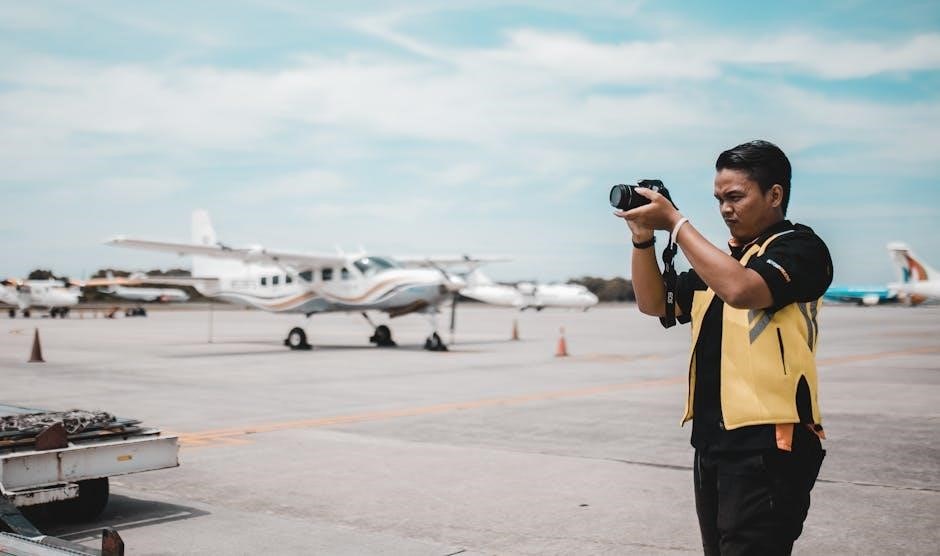
Flight Instruments and Avionics
Flight instruments and avionics are essential for navigation and safety. This section explores primary instruments like altimeters and heading indicators, as well as advanced systems for modern cockpits.
4.1 Primary Flight Instruments
Primary flight instruments are vital for maintaining situational awareness. The altimeter indicates altitude, the airspeed indicator shows speed, the heading indicator displays direction, and the attitude indicator provides pitch and roll. These tools are fundamental for safe and controlled flight, helping pilots make informed decisions during all phases of aviation. Mastering their use is essential for every private pilot.
4.2 Advanced Avionics and Navigation Tools
Modern aircraft utilize advanced avionics systems, including GPS navigation, autopilot, and glass cockpits. These tools enhance precision, reduce workload, and improve situational awareness. Understanding how to operate systems like ADS-B, WAAS, and electronic flight instruments is crucial for safe and efficient navigation in complex airspace. These technologies integrate seamlessly, providing real-time data for better decision-making and flight management.

Weather and Meteorology
Weather and meteorology are crucial for flight safety, involving understanding weather theory, forecasts, and conditions. Recognizing patterns like cloud formations and wind shifts is essential for pilots to make informed decisions, ensuring safe flight operations by anticipating and preparing for various weather challenges.
5.1 Understanding Weather Theory
Understanding weather theory is fundamental for pilots, as it explains the principles behind atmospheric conditions. It covers the structure of the atmosphere, temperature inversions, humidity, and the formation of clouds, fog, and precipitation. Comprehending these elements helps pilots predict weather patterns, identify potential hazards like thunderstorms or icing conditions, and make informed decisions to ensure safe flight operations. This knowledge is vital for pre-flight planning and in-flight adjustments.
5.2 Reading Weather Forecasts and Reports
Reading weather forecasts and reports is crucial for safe flight planning. Pilots must interpret METARs (current weather reports) and TAFs (forecasts) to understand conditions like wind, visibility, clouds, and precipitation. These documents use standardized codes, such as ICAO airport codes, to convey information efficiently. Accurate interpretation ensures informed decision-making, enabling pilots to avoid hazards and comply with aviation regulations. Mastery of weather reports is essential for flight safety and efficiency.
Navigation and Communication
Navigation and communication are critical skills for pilots, ensuring safe and efficient flight operations. They involve using tools like GPS, VOR, and radios to maintain situational awareness and comply with ATC instructions.
6.1 Fundamentals of Navigation
Mastering navigation is essential for private pilots, involving the use of charts, compasses, and electronic aids. Pilots learn to plot courses, determine headings, and estimate en route times. Understanding magnetic variations and waypoints ensures accurate flight paths. Additionally, interpreting sectional charts and using GPS enhances situational awareness, making navigation precise and reliable during cross-country flights.
6.2 Radio Communication Procedures
Effective radio communication is critical for private pilots. It involves using standard phraseology, understanding ATC instructions, and transmitting clear, concise information. Pilots learn to request clearances, report positions, and handle emergencies. Proper communication ensures safety, avoids conflicts, and maintains orderly air traffic flow. Regular practice and familiarity with aviation terminology enhance proficiency in this essential skill.
Regulations and Air Traffic Control
Understanding aviation regulations and air traffic control procedures is essential for safe and legal flight operations. Pilots must comply with FARs and communicate effectively with ATC to ensure seamless coordination and adherence to aviation laws.
7.1 Federal Aviation Regulations (FARs)
Federal Aviation Regulations (FARs) are the rules governing aviation in the U.S., ensuring safety and order in the skies. For private pilots, FARs cover pilot certification, aircraft maintenance, and operational standards. Compliance is mandatory, and understanding these regulations is crucial for legal and safe flight operations. They provide clear guidelines on everything from medical requirements to flight procedures, forming the foundation of a pilot’s responsibilities and practices.
7.2 Communicating with Air Traffic Control
Effective communication with air traffic control (ATC) is vital for safe flight operations. Pilots must use clear, concise language, following standardized phrases and procedures. Proper communication ensures smooth coordination between aircraft and ground personnel, preventing misunderstandings and potential hazards;
Key elements include using correct call signs, adhering to ATC instructions, and maintaining situational awareness. Listening actively and confirming instructions are equally important to ensure compliance and safety in all phases of flight.
Safety and Emergency Procedures
Safety is paramount in aviation. Private pilot training emphasizes emergency preparedness, including protocols for system failures, medical emergencies, and adverse weather conditions. Regular drills and checklists ensure readiness, while clear communication and quick decision-making are essential to manage crises effectively, safeguarding both the aircraft and its occupants.
8.1 Safety Best Practices
Safety best practices are the cornerstone of private pilot training. These practices include adhering to pre-flight checklists, maintaining situational awareness, and following established protocols for normal and emergency operations. Pilots should stay vigilant for potential hazards, such as weather changes or aircraft malfunctions, and always prioritize proactive risk management. Regular training and review of safety procedures ensure a high level of preparedness and compliance with aviation standards.
8.2 Emergency Protocols and Procedures
Emergency protocols are critical for ensuring safe outcomes in unforeseen situations. Pilots must be well-versed in procedures for engine failure, system malfunctions, and medical emergencies. Key steps include assessing the situation, declaring an emergency with ATC, and following established checklists. Regular practice of these protocols enhances readiness and decision-making under pressure. Always prioritize passenger safety and adhere to post-emergency reporting requirements to facilitate investigations and improvements.

Pre-Flight Preparation
Pre-flight preparation involves thorough checks of weather, aircraft systems, navigation tools, and safety equipment. A detailed flight plan ensures readiness for safe and efficient flight operations.
9.1 Pre-Flight Inspections
Pre-flight inspections are critical to ensure the aircraft is airworthy. Check the exterior for damage, tires, brakes, and fluid levels. Inspect the interior for proper control functionality, instrument accuracy, and safety equipment availability. Verify all systems, including navigation and communication tools, are operational. This thorough process ensures the aircraft is ready for a safe and successful flight.
9.2 Flight Planning and Briefings
Flight planning involves mapping out a detailed route, considering weather, air traffic, and fuel requirements. Briefings ensure all crew members understand the plan, safety protocols, and potential challenges. This step is crucial for ensuring a smooth, safe, and efficient flight, adhering to aviation regulations and best practices.

In-Flight Operations
In-flight operations involve managing aircraft systems, monitoring instruments, maintaining altitude and airspeed, and ensuring smooth navigation and communication throughout the flight.
10.1 Aircraft Handling and Maneuvers
Mastery of aircraft handling and maneuvers is critical for safe and precise flight operations. Pilots learn to control the aircraft smoothly during climbs, descents, turns, and level flight. Proper use of flight instruments and understanding of aerodynamic principles ensure effective maneuver execution. Emphasis is placed on maintaining safety, precision, and adherence to FAA guidelines during all in-flight operations.
10.2 Managing Altitude and Airspeed
Effective management of altitude and airspeed is essential for maintaining control and safety during flight. Pilots must consistently monitor and adjust these elements to navigate various conditions. Proper techniques ensure smooth transitions between climbs, descents, and level flight, adhering to FAA guidelines. This skill is vital for both routine operations and emergency procedures, ensuring the aircraft performs optimally in all situations.
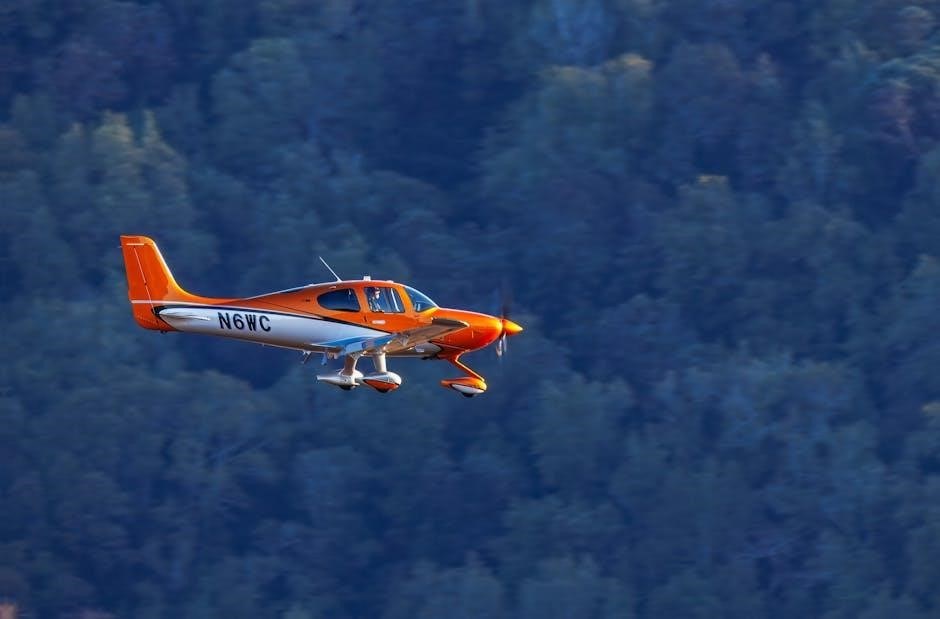
Post-Flight Procedures
Post-flight procedures ensure aircraft safety and readiness for future flights, involving securing systems, conducting inspections, and recording flight data for maintenance and review purposes.
11.1 Securing the Aircraft
Securing the aircraft post-flight involves several critical steps to ensure safety and prevent damage.
Start by shutting down the engine and electrical systems, then secure ignition switches.
Tie down the aircraft using ropes or chains to prevent wind damage.
Chock the wheels to immobilize the plane and engage the parking brake.
Additionally, drain fuel from the carburetor if required and cover sensitive components.
Finally, conduct a post-flight inspection to identify any issues and document findings for maintenance.
11.2 Post-Flight Checks and Reporting
After securing the aircraft, conduct a thorough post-flight inspection to identify any damage or malfunctions.
Review aircraft systems, including fuel levels, oil, and tire condition.
Document all findings and report any issues to maintenance personnel.
Complete a post-flight report, detailing flight performance, anomalies, and required repairs.
This ensures safety and compliance with regulatory standards, while maintaining aircraft airworthiness for future flights.
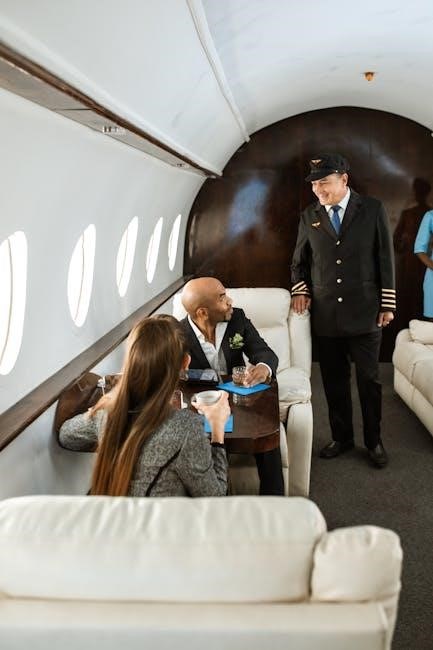
Cross-Country Flying
Cross-country flying involves navigating long-distance flights to unfamiliar airports, enhancing your piloting skills and confidence. Proper planning, navigation, and emergency preparedness are crucial for safe and successful journeys.
12.1 Planning Cross-Country Flights
Planning cross-country flights requires meticulous preparation. Pilots must analyze weather forecasts, air traffic control requirements, and aircraft performance. Route selection, fuel calculations, and emergency landing spots are critical. Utilizing sectional charts and digital tools ensures accurate navigation. A thorough pre-flight briefing with ATC and filing a flight plan enhances safety. Staying informed about NOTAMs and TFRs is essential for a smooth journey. Adequate planning ensures efficiency and minimizes risks.
12.2 Navigating and Landing at Unfamiliar Airports
Navigating and landing at unfamiliar airports requires careful preparation. Research the airport layout, runways, and approach procedures using sectional charts and digital tools. Communicate clearly with ATC for vectors or visual approaches. Familiarize yourself with local weather conditions and potential hazards. Use visual cues, such as runway markings and wind indicators, to align with the landing strip. Practice standardized landing techniques to ensure safety and precision at new locations.
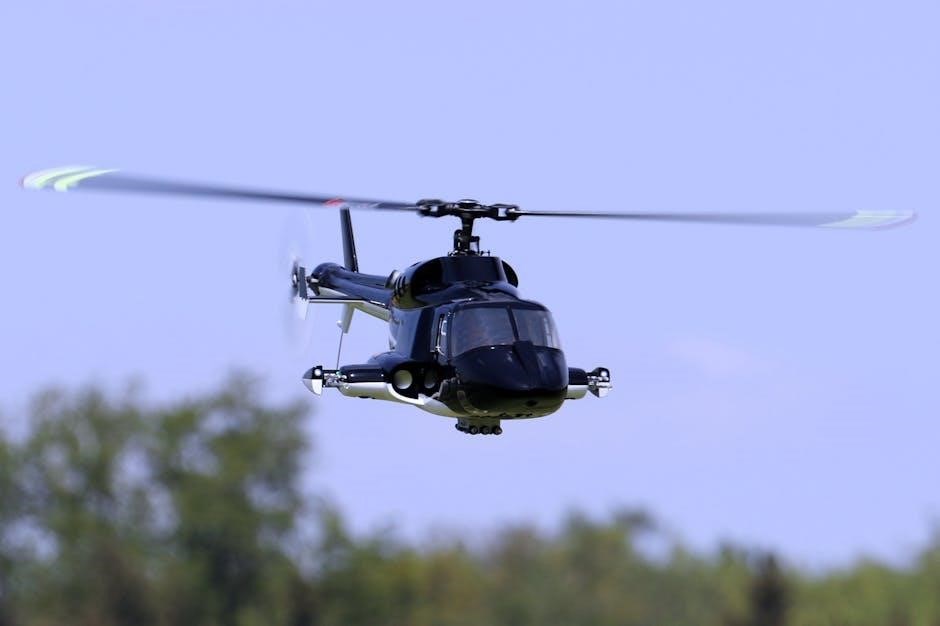
Ground School and Theory
Ground school provides essential theoretical knowledge, covering aerodynamics, weather theory, navigation, and regulations. It prepares students for written exams and lays the foundation for practical flight training.
13.1 Aerodynamics and Weather Theory
Aerodynamics explores the forces acting on an aircraft, such as lift, drag, thrust, and weight. Weather theory explains atmospheric conditions, including clouds, winds, and precipitation, impacting flight safety. Understanding these principles is crucial for predicting and navigating various flight conditions, ensuring safe and efficient piloting. These concepts form the foundation of a pilot’s knowledge, enabling informed decision-making during pre-flight planning and in-flight operations.
13.2 Navigation and Regulations
Navigation involves using charts, compasses, and electronic tools to guide the aircraft safely. Regulations, such as FARs, dictate legal requirements for flight operations, including airspace rules and communication protocols. Understanding these principles ensures compliance and safe flight operations. Pilots must master both navigation techniques and regulatory knowledge to operate effectively within the aviation system, maintaining safety and adherence to legal standards at all times.
Written Exam Preparation
Preparation involves studying FAA materials, textbooks, and online courses. Practice tests and flashcards help assess readiness, ensuring a strong understanding of aviation concepts and regulations.
14.1 Study Materials and Resources
Effective preparation requires utilizing a variety of study materials, including FAA publications like the Pilot’s Handbook of Aeronautical Knowledge and the Aeronautical Information Manual. Additionally, online courses, practice test software, and flashcards are invaluable tools to reinforce concepts and identify areas needing further review. These resources ensure a comprehensive understanding of aviation principles, weather, navigation, and regulations, crucial for exam success.
14.2 Practice Tests and Exam Strategies
Mastering the written exam requires strategic preparation. Regular practice tests help identify weak areas and build confidence. Focus on understanding concepts rather than memorizing answers. Develop a study schedule, review incorrect questions, and simulate exam conditions to improve time management and accuracy. Employ active learning techniques to retain information effectively, ensuring readiness for the actual test.
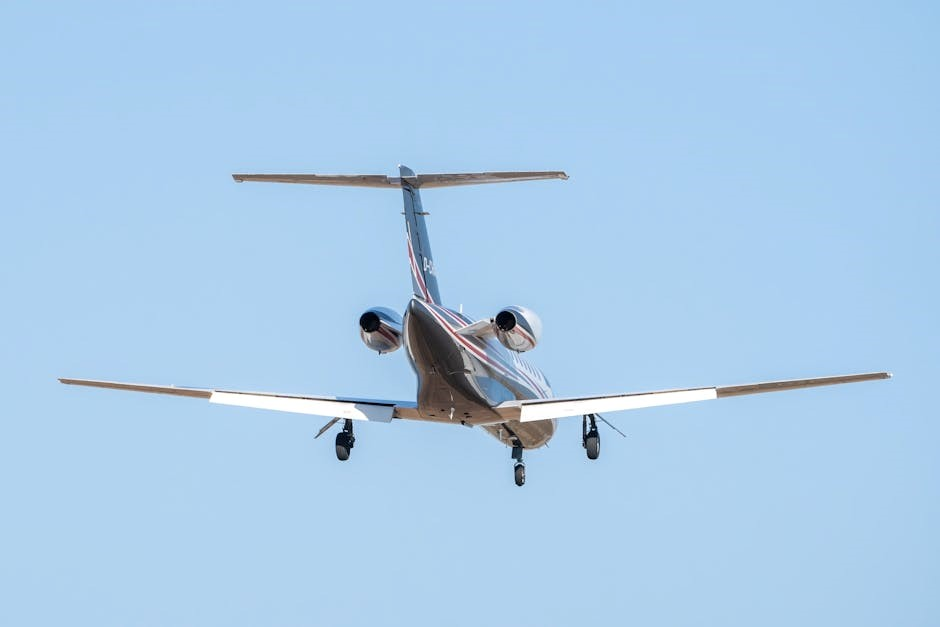
Practical Test (Checkride)
The practical test, or checkride, is a comprehensive evaluation of your flying skills, knowledge, and decision-making. An examiner assesses your ability to safely operate an aircraft, with difficulty increasing until you must consult FAR/AIM.
15.1 Preparing for the Checkride
Preparing for the checkride involves rigorous practice, reviewing flight maneuvers, and understanding FARs. Focus on consistency, accuracy, and safety. Regular flight lessons and ground school ensure readiness. Simulate exam conditions to build confidence and identify areas for improvement. A well-organized pre-flight briefing and thorough aircraft inspection demonstrate professionalism and preparedness to the examiner.
15.2 What to Expect During the Flight Test
During the checkride, the examiner evaluates your ability to safely operate the aircraft, follow procedures, and make sound decisions. Expect a structured assessment of pre-flight preparations, takeoffs, landings, and navigation. Be prepared to demonstrate emergency procedures and communicate clearly with air traffic control. The examiner will observe your adherence to FARs and ability to handle unexpected scenarios professionally. Stay calm, focus, and showcase your skills confidently.
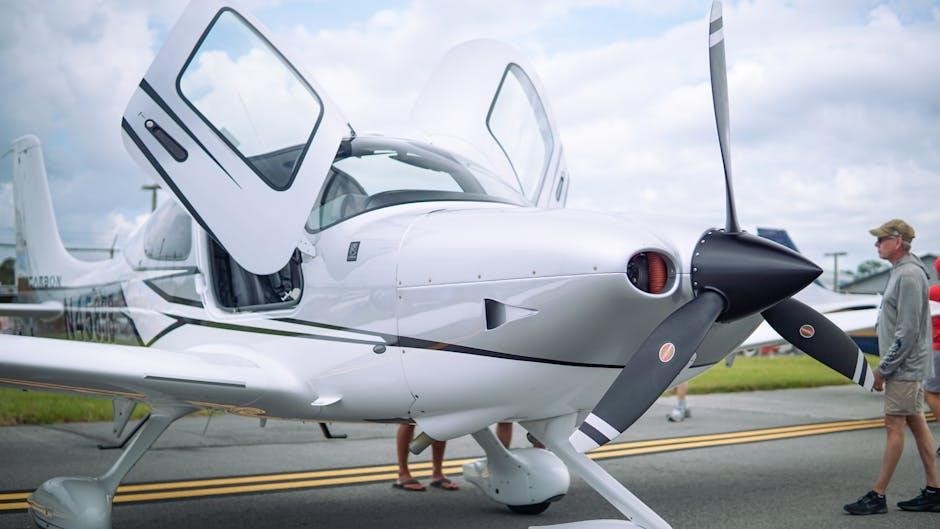
Continuous Learning and Improvement
Continuous learning is essential for pilots to stay proficient and adapt to evolving aviation standards. Regular training, seminars, and self-study ensure a safe and skilled flying career.
16.1 Staying Proficient as a Pilot
Maintaining pilot proficiency requires regular flight practice, adherence to safety protocols, and engagement with ongoing education. Pilots should schedule periodic flight reviews and stay updated on aviation regulations and advancements in technology to ensure safe and efficient flight operations.
16.2 Resources for Ongoing Education
Continuous learning is essential for pilots, with resources like FAA publications, online courses, and aviation communities offering updates on regulations and best practices. Flight simulation tools and recurrent training programs also provide hands-on experience, ensuring pilots stay proficient and adaptable to evolving aviation standards.